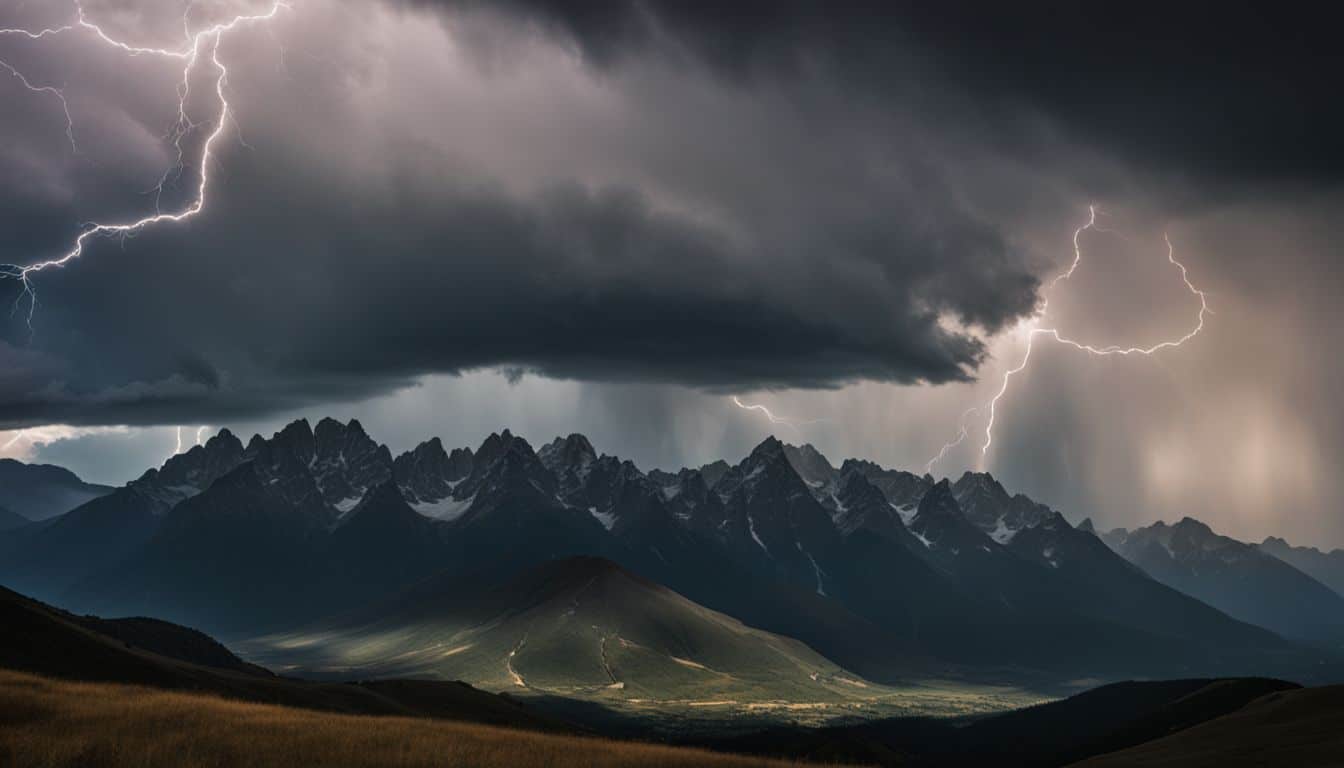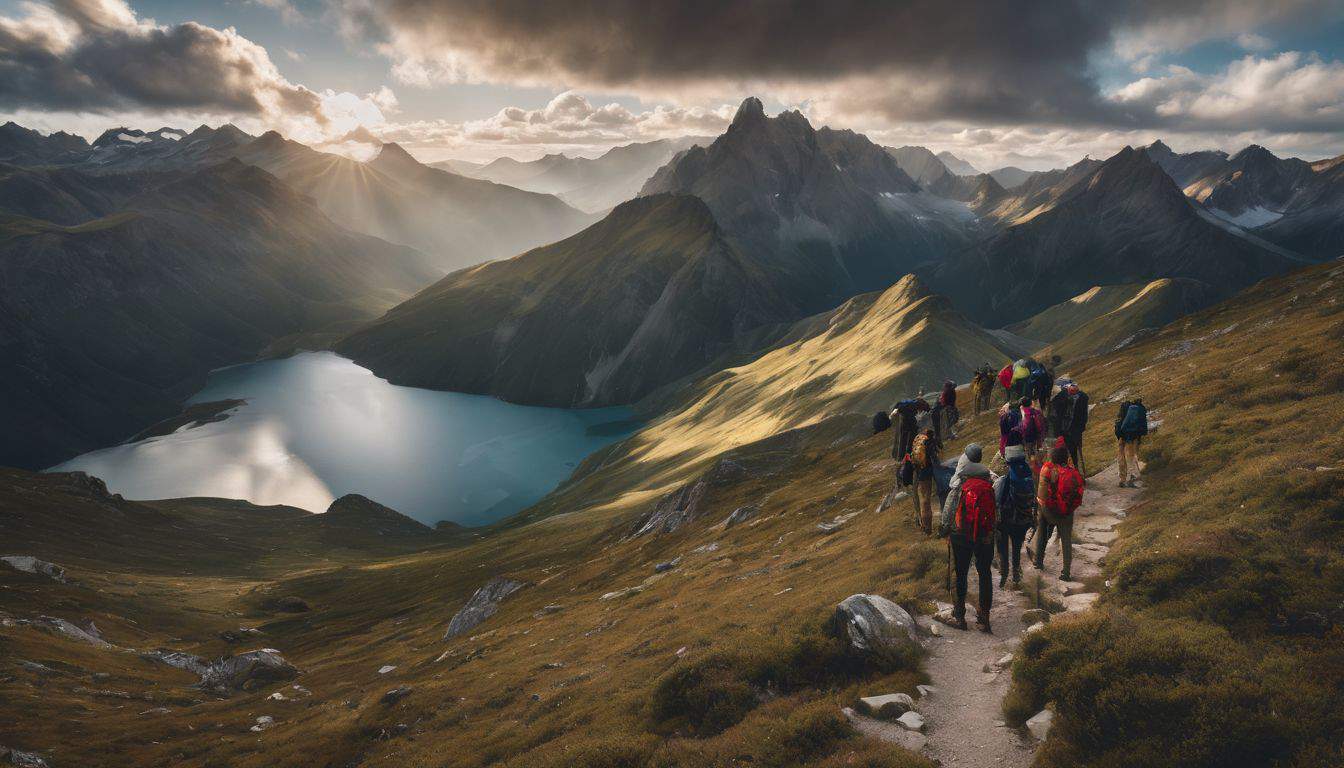Ever find yourself deep in the wilderness, puzzling over what Mother Nature might have planned for you? I’ve certainly trodden that path too, feeling unsure whether the skies are promising a safe hike or coaxing me to bunker down for the night.
After delving into age-old wisdom and contemporary science, I’ve discovered some incredible ways that nature herself can help us foretell weather patterns. In this blog post, we’ll tackle five ingenious strategies involving cloud interpretation, wildlife observation, understanding pressure shifts and even making sense of old adages – all practical skills vital for any adventurer keen on mastering wild weather prediction.
So gear up! It’s time to transform into a self-reliant meteorologist of the backcountry. Let’s jump right in to reading weather signs in the wild!
Key Takeaways
- Understanding air pressure can help predict weather patterns. High-pressure systems bring sunny days, while low-pressure systems can indicate storms or drastic climate changes.
- Observing wildlife behavior, such as birds flying high or animals acting strange, can provide clues about upcoming weather conditions.
- Reading cloud formations and paying attention to their height and spread can give insights into the weather forecast.
- Traditional weather sayings and old adages have proven to be accurate over time in predicting the weather.
Pressure
Weather changes often link with air pressure. A tool called a barometer measures this pressure. High-pressure systems make for sunny days and clear skies. They bring stable weather conditions.
So, if you spot high pressure on your barometer, expect good weather.
Yet, not all is calm in the world of meteorology! Low-pressure systems spell trouble. They can cause storms or even drastic climate change patterns. If your barometer points to low pressure, brace yourself! Bad weather might be coming your way.
Watch Critters
Birds in the sky give clues about the weather. Hawks flying high means clear skies. You can trust this sign because their sharp eyes need good light. But, if birds fly low, look out! They feel a storm coming.
Animals help us know about bad weather too. Critters act strange when a storm is near. Their ears and noses pick up signs we miss. For example, they move a lot more than usual during these times.
So keep an eye on critters for any weird moves! It’s like they have superpowers to tell what the weather will do next. We just have to watch them closely and learn their language.
Read Clouds
Clouds tell us a lot about the weather. Look up at the sky and they can show you what to expect. Low clouds usually mean bad weather is near. The weather often gets clear when clouds rise and spread out.
I always watch for cirrocumulus clouds. These look like ripples on a lake and point to good weather ahead. Stormy times call for special storm clouds, so I keep an eye out for those too.
Plus, sunrise and sunset give me clues about the next 12 hours of weather.
Reading clouds becomes second nature with practice. It’s been a great help in my backpacking trips where the climate shifts fast in wild areas.
Old Weather Sayings
I love learning about old weather sayings and folklore. It’s fascinating how our ancestors used nature to predict the weather without fancy technology. There are so many traditional sayings that have proven to be true over the years.
For example, “Red sky at night, sailor’s delight; red sky in morning, sailors take warning” is actually accurate! Another one I find interesting is “When the cows lie down in the field, it means rain is near.” Animals like wolves, birds, squirrels can also give us clues about upcoming weather patterns.
It’s amazing how much we can learn from observing nature!
Smell of the Woods
The smell of the woods can help us predict the weather in the wild. When I’m out in nature, I pay attention to the forest scent because it holds important clues about what’s going on with the weather.
Environmental signs and natural indicators are all around us if we know how to interpret them. For example, different cloud formations can tell us if there’s a storm coming or if it will stay clear.
By studying real-life examples and learning about humidity levels, we can become better at reading these signs.
Another interesting aspect is the smell of rain, known as petrichor. Even on days without rain, we may still detect this fragrance if there has been recent digging nearby. This tells us that moisture is present in the air and that rain might be on its way.
By paying attention to these smells and scents in nature, we can become more attuned to our surroundings and better equipped for survival in the wilderness.
Overall, understanding how to read weather signs through the smell of the woods is an essential skill for any survival enthusiast. It allows us to make informed decisions when planning outdoor activities or navigating through unfamiliar terrain.
So next time you’re out in nature, take a deep breath and let your nose guide you towards mastering this fascinating skill of weather prediction using environmental cues and natural scents found within our surroundings.
Types of Water Filters
Water filters are essential for survival in the wild. Here are some types of water filters you should know:
- Wood Filters: These natural filters use a piece of wood to purify water by trapping impurities and bacteria, leaving you with clean drinking water.
- Hot Rock Filters: Heating rocks and submerging them in water can kill off bacteria and microorganisms, making the water safe to drink.
- Boiling Water: The traditional method of boiling water is still effective. Simply bring the water to a rolling boil for a certain period of time to eliminate harmful contaminants.
- Distillation Filters: This advanced method involves evaporating the water and then condensing the vapor to collect purified water. It effectively removes impurities, ensuring safe drinking water.
Benefits of Water Filters
Water filters offer numerous benefits for survival enthusiasts like us. Let me tell you some of the key advantages:
- Plastic waste reduction: By using a water filter, you can reduce your reliance on single-use plastic bottles, helping to minimize plastic waste.
- Wildlife conservation: Water filters remove pollutants from water sources, protecting wildlife and their habitats.
- Appliance efficiency: Clean and filtered water improves the efficiency of appliances such as coffee makers and dishwashers, saving energy in the process.
- Energy conservation: By reducing the need for bottled water production and transportation, water filters contribute to overall energy conservation efforts.
- Pollutant removal: Water filters effectively remove contaminants like chlorine, lead, and bacteria from drinking water, ensuring cleaner and safer hydration.
- Fossil fuel reduction: With fewer plastic bottles being produced and transported, the consumption of fossil fuels associated with these activities is reduced.
- Single-use plastic reduction: Using a water filter allows you to avoid purchasing single-use plastic bottles, contributing to the reduction of plastic pollution in landfills and oceans.
- Appliance longevity: By providing clean water free from minerals and impurities, water filters can extend the lifespan of appliances that use water.
Latest Innovations in Water Filter Technology
Scientists and researchers are constantly developing new technologies to tackle the challenge of water scarcity and ensure access to clean drinking water. Some of the latest innovations in water filter technology include desalination systems, which remove salt from seawater to make it drinkable, and nanotechnology water treatment, which uses tiny particles to filter out contaminants.
Another exciting development is solar water filtration, where sunlight is used to purify water by killing bacteria and viruses. These advancements are crucial for providing clean water in areas where traditional methods may not be effective.
Other alternative methods like wood filters and hot rocks are also being explored as affordable options for purifying water in the wild.

How to Choose the Right Water Filter
Choosing the right water filter is important, especially when you’re out in the wild. Here are some things to consider:
- Different types of water filters have different filtration rates, so think about how fast you need clean water.
- Keeping clean and dirty things separated and labeled is helpful for staying safe in the wild. This includes your water filter system.
- Scouts working on the Wilderness Survival merit badge learn how to anticipate and avoid hazards in backcountry adventures. Think about what kind of hazards you might encounter and choose a water filter that can handle those risks.
- It can be difficult to determine if a whole house/point-of-entry (POE) system or a point-of-use (POU) system is needed for a home water filter. Consider the size of your group and how much water you’ll need to filter.
- Understanding water quality concerns is important. Do some research on the area where you’ll be using your water filter and choose one that can handle any specific issues.
- Budget is always something to consider. There are many options available at different price points, so find one that fits your budget.
- Lifestyle plays a role too. If you’re constantly on-the-go, a portable and lightweight water filter might be best for you.
- Clean and dirty separation is crucial when it comes to handling water filters in the wild, so make sure your chosen filter has easy-to-use features for this.
- Anticipating and avoiding hazards should be kept in mind while choosing a water filter, as certain models may offer better protection against specific dangers.
- Finally, always remember to follow manufacturer recommendations and instructions when using a water filter.
Clues in Nature
I love exploring the outdoors and learning how to navigate through nature. One important skill I’ve picked up is reading the clues that nature gives us. By observing the environment around me, I can make predictions about what might happen next.
For example, animals leave tracks and signs behind that can tell us a lot about what’s happening in an area. If I see fresh animal tracks, it could mean there are predators nearby or that there’s a water source close by.
These are all important things to know when you’re out in the wilderness.
Nature also gives us hints about upcoming weather changes. By looking at clouds and wind speed, we can get a sense of whether rain or storms are on their way. The direction of the wind can even tell us if a cold front is coming or if warm weather is approaching.
Observing patterns in nature helps me feel more connected to my surroundings and makes me feel confident as I explore new areas. It’s incredible how much information we can gather just by paying attention to the clues that nature provides.
Cats & Crickets
Cats and crickets can help us predict the weather in the wild. Crickets, those little insects that chirp at night, have a special talent for forecasting. Their chirping patterns can give us clues about the temperature outside.
The frequency of their chirps can indicate if it’s warm or cold. By counting how many times they chirp in 14 seconds, we can calculate the temperature in Fahrenheit.
It’s important to remember that crickets are cold-blooded creatures, which means their bodies take on the temperature of their surroundings. This affects their chirping patterns. So if you hear a lot of cricket chirps, it might mean that it’s warm outside.
On the other hand, if you don’t hear as many chirps, it could be an indicator of colder temperatures.
Cats also have a role to play in reading weather signs. They are known for being sensitive to changes in atmospheric pressure before a storm arrives. If your cat starts acting restless or seeking shelter indoors, it could be a sign that bad weather is on its way.
So next time you’re out in nature and want to get an idea of what the weather will be like, keep an ear out for cricket chirps and pay attention to your feline friend’s behavior – they might just give you some helpful hints!
Lightning & Thunder
Lightning and thunder are natural phenomena that can be both fascinating and dangerous. Lightning occurs during thunderstorms and is caused by the discharge of electricity in the atmosphere.
It is one of the oldest observed natural occurrences on Earth. Thunder, on the other hand, is the sound produced by lightning due to its intense heat causing air to expand rapidly.
It’s important to remember that lightning can be extremely dangerous and cause fatalities or injuries. On average, there are 93 deaths and 300 injuries related to lightning each year.
When you’re caught outside during a thunderstorm, it’s crucial to seek shelter immediately. Avoid tall trees, hills, ridges, or any high spots as lightning tends to be attracted to these areas.
It’s interesting to note that lightning can also be seen in volcanic eruptions, intense forest fires, and surface nuclear events. This phenomenon shows just how powerful and awe-inspiring nature can be.
In conclusion, while lightning and thunder may provide a spectacular show of nature’s power, they should always be treated with caution. Stay safe during storms by seeking shelter indoors until it passes overhead.
Conclusion on Reading Weather Signs in the Wild
In conclusion, mastering the art of reading weather signs in the wild can greatly enhance your survival skills. By understanding pressure changes, observing animal behavior, reading cloud formations, and relying on old weather sayings, you can become more knowledgeable in predicting the weather.
So get out into nature and start honing your weather forecasting skills today!
FAQs on Reading Weather Signs in the Wild
1. Why is it important to read weather signs in the wild?
Reading weather signs in the wild is important for your safety and well-being. It helps you anticipate changes in weather conditions and make informed decisions while outdoors.
2. What are some common weather signs to look out for?
Common weather signs include darkening clouds, increasing wind speed, sudden drop or rise in temperature, and changes in animal behavior.
3. How can I learn to read weather signs effectively?
You can learn to read weather signs effectively by observing nature, studying meteorological resources, and gaining experience through outdoor activities.
4. Can reading weather signs accurately predict the future forecast?
While reading weather signs can provide valuable insights into short-term changes, it may not accurately predict long-term forecasts as it relies on observations rather than scientific measurements.
5. Are there any risks involved in relying solely on reading weather signs?
Relying solely on reading weather signs can pose risks as it may not always be reliable or comprehensive enough to account for sudden shifts or extreme conditions. It’s advisable to also consult official forecasts when planning outdoor activities.





Leave a Reply